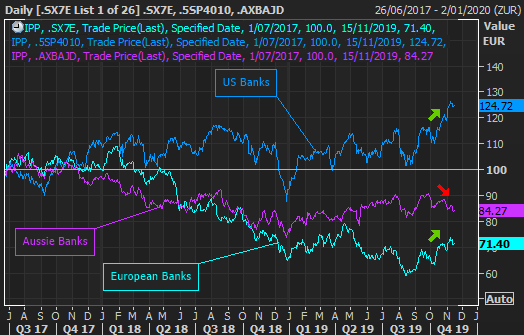*China cut reverse-repo rate from 2.55% to 2.5%
*GBP price action leans towards UK Conservative majority
*European banks lag rest of the world but seem to be on the improve
Markets buy into surprise China cut
Taking stock of Asia price action, it was modest with G10 FX and equities marginally risk-off across the board. ASX Cash dropped -0.4% and was down 27pts on the open. Risk however has since steadied off the back of China's unexpected cut to its 7-day reverse repo rate - a short-term funding cost - from 2.55% to 2.5%. This marks the first reduction made since October 2015 and builds on the PBOC's recent trim to the medium-term lending (MLF), used by banks for longer-term funding needs. EURUSD and GBPUSD are high beta in early European trading up 0.10% and 0.20% respectively. Given that Monday's calendar looks negligible, China's unexpected cut could help lean risk sentiment positive for most of today's European trading. We also expect the PBOC to make a third cut to its LPR rate later this week.
Conservative majority looking more likely
GBPUSD made a move back above 1.29 late Friday after UK election headlines hit the wires once again. This time, the Brexit Party announced it would stand down from 43 non-Conservative seats. We noted previously that developments out of the Brexit Party reduced the risk of a No Deal Brexit; markets appear to be treating this news in a similar fashion. Markets are pricing in a strong likelihood that Conservatives maintain majority at the upcoming December 12 election. Our expectation is for Sterling price action to remain most sensitive to election prospects. Should a Conservative majority sustain as the base case, we think this puts a medium-term bullish bias on GBPUSD. Look to PM Johnson's debate with Labour leader Corbyn on Tuesday, Nov 19 for further signals.
US banking sector still on top
The global banking sector has generated average returns over the last two and a half years, primarily driven by accommodative monetary policy which has lowered interest rates, and therefore, naturally put a squeeze on profitability or net interest margins (for those more technical). US banking stocks however have been somewhat protected, managing to outperform arguably due to their more varied revenue streams in M&A and trading. These activities not only act to diversify their cash flows but are able to fill their coffers in equity bull markets (higher valuations tend to lead to more M&A activity). On the other hand, European banks - arguably less diversified and having to deal with negative-yielding rates - have been hurt the most. Though having said that, returns have improved since the ECB's last rate cut where several measures meant to keep bank funding costs down were introduced. European banks have outperformed in recent times and could start to look like a better bet when compared to the Aussie banking sector which has suffered under the
RBA's numerous insurance cuts in 2019.

Indexed price performance from the middle of 2017. Source: Eikon
In case you missed it, see:
Back